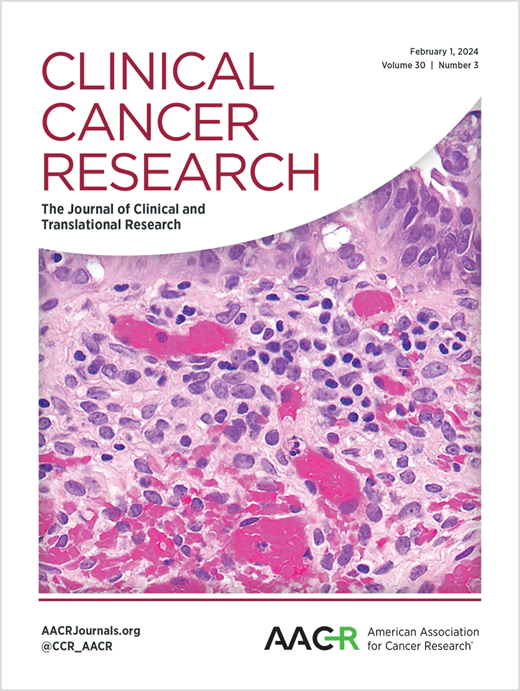FHD-286是一种双重BRG1/BRM (SMARCA4/SMARCA2)抑制剂,用于晚期髓系恶性肿瘤患者的i期研究
IF 10
1区 医学
Q1 ONCOLOGY
引用次数: 0
摘要
目的:评估BRG1/BRM双抑制剂FHD-286在复发/难治性急性髓系白血病或骨髓增生异常综合征患者中的安全性和初步临床活性。患者和方法:在这项多中心、开放标签、一期剂量递增研究(NCT04891757)中,患者每天口服一次FHD-286,剂量分别为2.5、5、7.5和10mg。结果:40例患者(中位年龄65.5岁;85%遗传状况不良;65%(既往治疗线≥3条)接受FHD-286治疗28天(中位数)。FHD-286在10 mg QD时无耐受性。在所有剂量中,治疗相关不良事件(TRAEs)主要为1-2级,最常见的是口干(27.5%)和谷丙转氨酶升高(20%)。剂量限制性3级高胆红素血症和3级肌肉无力分别发生在5和10 mg QD。最常见的严重TRAE是分化综合征(DS)(10%)。独立委员会回顾性判定15%的患者发生DS(5例3级,1例4级)。FHD-286血浆暴露量随剂量增加而增加,并随持续给药而累积。伴随CYP3A4抑制剂的暴露通常更高。在细胞遗传学和突变背景中观察到骨髓分化和白血病负担减轻,特别是在增强子驱动基因型患者中。没有客观的反应。结论:DS是最常见的严重TRAE。虽然观察到抗白血病活性,但没有达到客观反应,并且在1-2个治疗周期内经常发生疾病进展。据报道,在细胞遗传学和突变谱中,母细胞减少,并通过BRG1/BRM抑制骨髓分化。这一新的机制值得进一步研究FHD-286联合其他药物治疗髓系恶性肿瘤。本文章由计算机程序翻译,如有差异,请以英文原文为准。
A Phase 1 Study of FHD-286, a Dual BRG1/BRM (SMARCA4/SMARCA2) Inhibitor, in Patients With Advanced Myeloid Malignancies
Purpose: Safety and preliminary clinical activity of FHD-286, a dual BRG1/BRM inhibitor, were evaluated in patients with relapsed/refractory acute myeloid leukemia or myelodysplastic syndrome. Patients and methods: In this multicenter, open-label, phase 1, dose escalation study (NCT04891757), patients received FHD-286 orally once daily (QD) at 2.5, 5, 7.5, and 10 mg. Results: Forty patients (median age 65.5 years; 85% with adverse genetic status; 65% with ≥3 prior therapy lines) received FHD-286 for 28 days (median). FHD-286 was not tolerated at 10 mg QD. Across all doses, treatment-related adverse events (TRAEs) were predominantly Grade 1-2, most commonly dry mouth (27.5%) and increased alanine aminotransferase (20%). Dose-limiting Grade 3 hyperbilirubinemia and Grade 3 muscular weakness occurred at 5 and 10 mg QD, respectively. The most common serious TRAE was differentiation syndrome (DS) (10%). An independent committee retrospectively adjudicated DS in 15% of patients (five Grade 3, one Grade 4). FHD-286 plasma exposure increased with dose and accumulated with continuous dosing. Exposures were typically higher with concomitant CYP3A4 inhibitors. Myeloid differentiation and leukemic burden reduction were observed across cytogenetic and mutational backgrounds, notably in patients with enhancer-driven genotypes. There were no objective responses. Conclusions: DS was the most frequent serious TRAE. While antileukemic activity was observed, no objective responses were achieved and disease progression frequently occurred within 1-2 treatment cycles. Blast reductions were reported across cytogenetic and mutational profiles, coupled with myeloid differentiation via BRG1/BRM inhibition. This novel mechanism warrants further investigation of FHD-286 in combination with other agents in myeloid malignancies.
求助全文
通过发布文献求助,成功后即可免费获取论文全文。
去求助
来源期刊

Clinical Cancer Research
医学-肿瘤学
CiteScore
20.10
自引率
1.70%
发文量
1207
审稿时长
2.1 months
期刊介绍:
Clinical Cancer Research is a journal focusing on groundbreaking research in cancer, specifically in the areas where the laboratory and the clinic intersect. Our primary interest lies in clinical trials that investigate novel treatments, accompanied by research on pharmacology, molecular alterations, and biomarkers that can predict response or resistance to these treatments. Furthermore, we prioritize laboratory and animal studies that explore new drugs and targeted agents with the potential to advance to clinical trials. We also encourage research on targetable mechanisms of cancer development, progression, and metastasis.
 求助内容:
求助内容: 应助结果提醒方式:
应助结果提醒方式:


